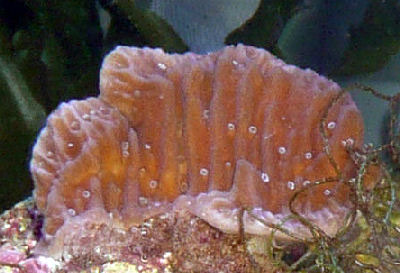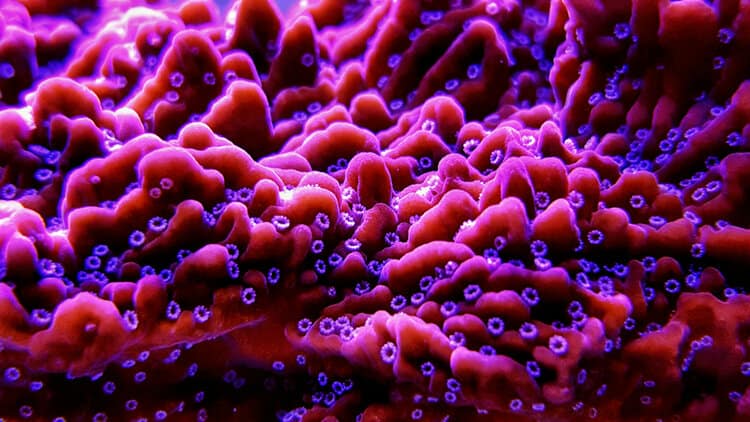
Very pretty purple with contrasting polyps, the Idaho Grape Montipora is a highly sought after, and pricey coral!
The Idaho Grape Montipora Montipora undata is a beautifully colored small polyp stony (SPS) coral. Although there has not been an official common name for it, it is generally known for its purple shading as “Idaho Grape”. It can also be pink, pale green, or brown with pale margins. The contrasting polyps are white, pink, brown, and rust. More colors may develop as this coral is aquacultured.
The M. undata is typically branching or in digitata form. Colonies have horizontal to vertical plates or tubes, and these columns and branches are generally thick. The wide variations in growth are more apparent in mature colonies.
This Montipora is easy to moderate to care for, and is less likely to bleach or get the diseases that the Acropora corals tend to get. It is not demanding as far as light and water movement, but temperature is a consideration. Interestingly, the skeletons of the Idaho Grape Montipora, like other corals of this type, hold heat. Consequently they do not tolerate temperatures over 80 degrees Fahrenheit very well.
The Montipora undata has been bred in captivity and has been known to double in size within a few months under the right conditions. The Idaho Grape Montipora is often confused with M. danae, consequently some may inadvertently sell an M. danae as the M. undata. You will want to identify it correctly before paying its high price. Once acquired and established, they are easy to propagate and can provide you with ample opportunities to frag.
- Kingdom: Animalia
- Phylum: Cnidaria
- Class: Anthozoa
- Order: Scleractinia
- Family: Acroporidae
- Genus: Montipora
- Species: undata
Scientific name
Family: Acroporidae
Species: Montipora undata
Distribution / Background
Montipora Coral Information: The Idaho Grape Montipora Montipora undata was described by Bernard in 1897. It has not had an official common name, but is generally known for its purple shading as the “Idaho Grape”.
Where Montipora Corals Are Found: The Montipora undata are found in Australia, the Philippines, and Indonesia. Around Australia they are found in the Great Barrier Reef, Coral Sea, and the Dampier Archipelago.
Montipora Coral Habitat: M. undata are found on upper reef slopes in water that is moderately turbulent, and at depths from 9 to 82 feet (3 to 25 m). Montipora, as a species, are found from deep water (greater than 10 meters / 33 feet) to the reef crest and from clear oceanic reefs to turbid (not clear because of stirred-up sediment, etc.) lagoons. Even though their range is large, Montipora are more likely to be found in quiet water at mid-depths.
Status
The Montipora undata is on the IUCN Red List for Endangered Species as Near Threatened (NT)
Description
What do Montipora Corals look like: The M. undata have very porous and lightweight skeletons. This species of small polyp stony (SPS) corals are typically branching or in digitata form. The colonies have horizontal to vertical plates or tubes, and these columns and branches are generally thick. These wide variations in growth are more apparent in mature colonies. It is often confused with M. danae but its raised reticulum is not as bulbous or dome shaped as M. danae, and are thinner or narrower.
The Idaho Grape Montipora can be purple, pink, pale green, or brown with pale margins and contrasting polyps that are white, pink, brown, and rust. More colors may develop as this coral is aquacultured.
Difficulty of Care
Montipora Coral Care: The M. undata is easy to moderate to care for, accepting a wide range of lighting and water movement. Unlike Acropora, which are in the same family, Montipora corals do not stress as easily and are more resistant to bleaching and disease. Some credit this resistance to their deep-set polyps. They are easy to propagate and are a perfect specimen for the captive reef environment.
Foods / Feeding
Montipora Coral Feeding: In the wild, Montipora corals have developed several feeding strategies. Through a symbiotic relationship with a marine algae, known as zooxanthellae, they receive the majority of their nutrients. They also capture planktonic organisms and microscopic food particles from the water column and can absorb dissolved organic matter.
In captivity, they do well in well-feed reef tanks, accepting very fine particulate foods. Zooplankton and tiny plankton can be fed once a week. Copepods, Artemia, and nauplii are too large for them to ingest. Most online vendors recommend adding filter feeder food. New forms of prey are also being developed, such as invert larvae and new strains of rotifers.
Aquarium Care
Pristine tank conditions are needed to keep all Montipora spp. corals. Doing water changes of 10% every 2 weeks is needed, although it is suggested that doing 5% water changes once a week will bring about amazing results. Keep the nitrate levels low. Maintaining calcium and alkalinity levels are important.
Suggested levels for Montipora species are:
- Calcium: 400 to 450 ppm (closer to 450). If the Monti does not have enough calcium, it will not grow.
- Alkalinity: 3.2 TO 4.5 MEQ/L (8 to 10 dKh – 10 is recommended)
- Phosphates: 0, zero. Phosphates are the worst of all and all corals hate them.
- Magnesium: 1350-1500. Magnesium makes calcium available, so if your calcium is low, check your magnesium levels before adding any more calcium.
- Strontium: 10
Aquarium Parameters
A well-feed live rock/reef environment is what is needed for your Idaho Grape Montiporal, along with some fish for organic matter production. These corals are usually hardy and fast-growing, however a mature tank is recommended.
| Quick Reference Chart | |||
|---|---|---|---|
| Lighting: | |||
| Water Flow: | |||
| Temperament: | |||
Do not place directly under metal halides due to the heat halides produce. The skeletons of the Idaho Grape Montipora, like other corals of this type, hold heat. Consequently they do not tolerate temperatures over 80 degrees Fahrenheit very well..
For tanks with metal halides, position your Monti in the mid levels. With other lighting, position your Monti at the upper to mid levels depending on the watts used. Your Monti will show whether it is happy or not by the coloring. Make sure that no other corals or even algae can come in contact with your Montipora. Monti’s are mild mannered and will end up loosing any chemical warfare.
- Minimum Tank Size / Length: 10 gallons (38 L) or larger
- Marine Lighting: All (within reef light parameters)
- Temperature: 72° – 80° F (22° – 27° C)
- Salinity / Specific Gravity: 1.023 – 1.025
- Water Movement: Moderate/turbulent
- Water Region: Middle to top of the aquarium
Compatibility and Social Behaviors
Montipora are not aggressive corals, nor do they posses strong defenses. Because of this, they must be placed away from any aggressive or defensive coral. Although not as touchy as Acroporas, the Montipora genus should still do best kept in a small polyp stony (SPS) tank. It will tolerate a mixed coral tank better than Acros, but plenty of room should be around your Montipora, even distancing it from another Montipora species. Oddly, colors can at times determine hierarchy in a tank. For instance, a brown Montipora undata will usually loose to attacks by their colored up sisters and brothers.
The Montipora genus are peaceful, but watch out for crabs. Many experienced aquarists do not believe in any crab should be kept in a closed system. Crabs are opportunistic predators, with the exception some of the symbiotic crabs like commensal crabs, and gall crabs.
Sex – Sexual differences
No sexual difference in appearance is known.
Breeding and Reproduction
The Montipora Sp. are male and female and can reproduce both sexually and asexually. In the wild they reproduce sexually by releasing eggs and sperm at the same time, resulting in a fertilized egg which then forms into a free-swimming planula larva. Eventually the planula larvae settles onto the substrate, becoming plankters. This then forms a tiny polyp which begins to excrete calcium carbonate and develops into a coral. Planula larvae are extremely vulnerable to predation, and very few survive. Montiporas reproduce asexually as well. In the wild Montiporas spread from breakage due to storms and fragmentation.
Propagation is rather simple for Montipora corals. First you need to choose a healthy coral that is not showing any signs of distress. Then, simply cut a branch at least 2″ long and glue the frag to a plug or rock. You can use the 2-part epoxy or underwater putties. A little tip, don’t glue frags upright since they will grow faster on their sides.The slime that the coral will exude should not come in contact with any other corals and gloves are suggested. Give the frag ample water flow.
Potential Problems
The Montipora spp. are generally disease resistant, but can still get the same illnesses that any other small polyp stony (SPS) coral can get under poor conditions. An ailment on some Montipora’s are tumor like growths, but these tumors are not harmful, just ugly. Caution is recommended if you plan to add Limpet snails to your tank as they have been known to eat Montipora corals (as well as Acropora). Magilopsis (a gastropod) and Prosthiostomum (a flatworm) are common Montipora pests.
In general, if your M. undata has any kind of tissue recession, just cut off the healthy part. Just make sure you cut into some of the healthy part also, to be sure there is no disease encroaching on the healthy tissue. Also, keep out the cyanobacteria and algae with good water movement, and your Monti will stay happy.
Availability
Montipora Corals for Sale: The Idaho Grape Montipora M. undata can sometimes be found at pet shops and on line. Online they can run about $149.00 USD or more depending on size. Frags are sometimes available, so getting your M. undata from a reef club may be more cost effective.
References
- Animal-World References: Marine and Reef
- Eric Borneman, Aquarium Corals : Selection, Husbandry, and Natural History , TFH Publications, 2001
- J.E.N. Veron, Corals of Australia and the Indo-Pacific , University of Hawaii Press; 2 Rev Ed edition, 1993
- Blane Perun, Montipora Undata, Blane Perun’s TheSea.org, Copyright 1999
Featured Image Credit: Vojce, Shutterstock
